Managing Diabetes Remotely — The VitalTrak Way
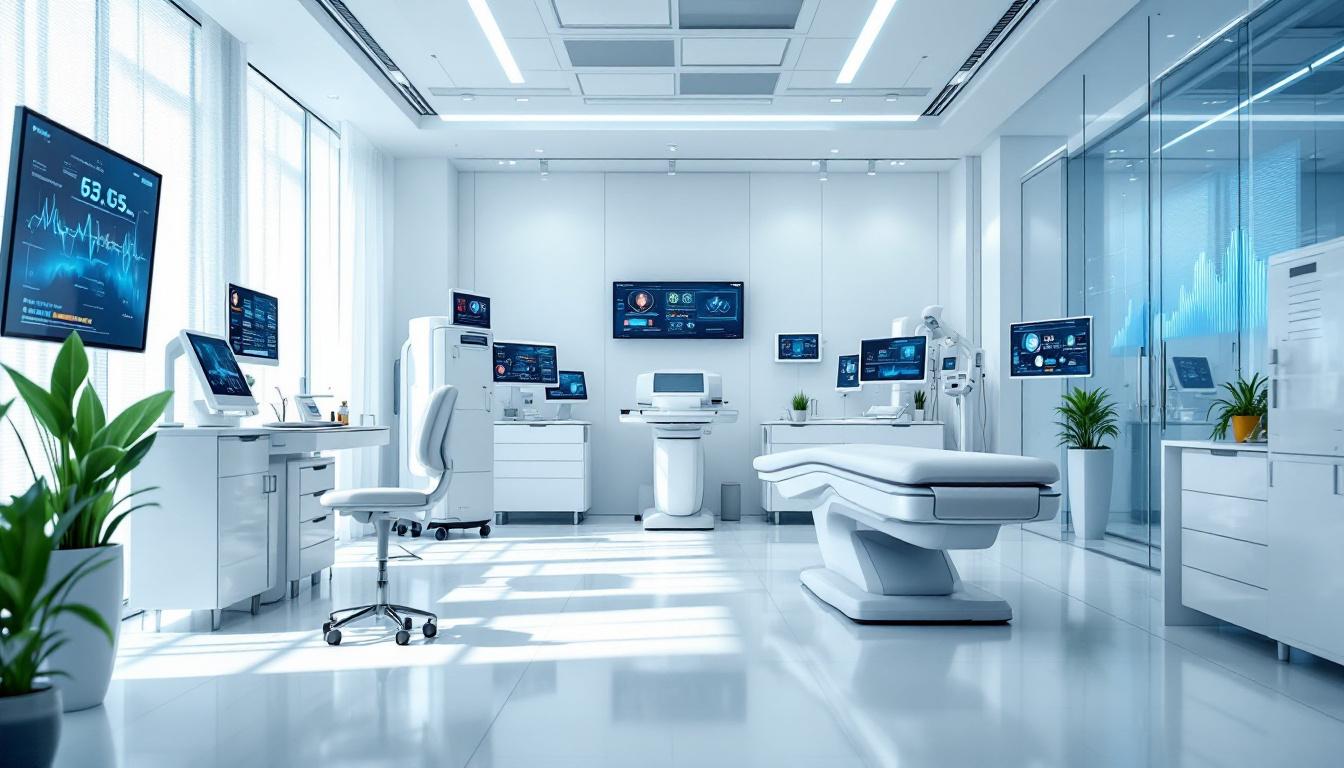
Introduction to Remote Diabetes Management
The landscape of diabetes care has experienced a revolutionary shift towards remote management, driven by technological advancements, global health challenges like COVID-19, and an increasing focus on patient-centered, accessible healthcare. The VitalTrak approach exemplifies how leveraging digital health tools, telemedicine, and remote patient monitoring (RPM) can optimize glycemic control, reduce complications, and improve quality of life for patients with diabetes. This article explores the strategies, technologies, benefits, challenges, and future directions of managing diabetes remotely, highlighting how integrated solutions are reshaping the standard of care.
Core Strategies and Techniques in Remote Diabetes Management
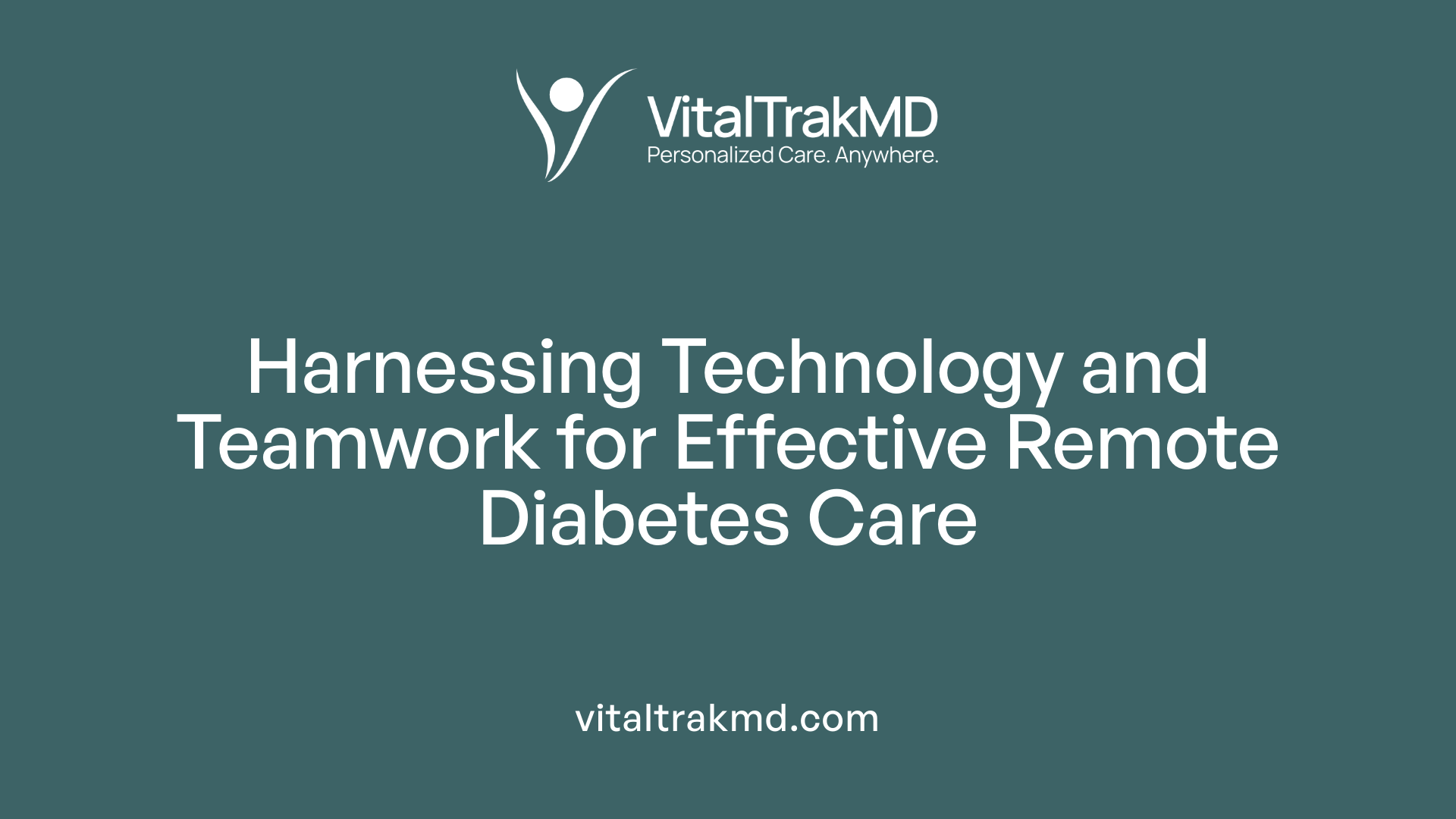
What are the main strategies and techniques for remote diabetes management?
Remote diabetes management relies on a combination of advanced digital health tools and structured clinical practices. The core approach involves using a variety of devices and platforms to gather and analyze critical health data in real time.
Digital health tools such as continuous glucose monitoring (CGM) systems—like Dexcom G6, Freestyle Libre, and Medtronic Guardian—along with connected blood glucose meters from brands like Accu-Chek and OneTouch enable patients to monitor their blood sugar levels continuously or periodically. These devices often transmit data automatically to clinicians, reducing manual recording errors and improving timely intervention.
In addition, smart insulin pens, insulin pumps, and health apps further support medication management while providing insights into insulin use and blood sugar trends. These tools are integrated into telehealth platforms that facilitate virtual consultations, tele-education, and remote monitoring—allowing healthcare providers to review data, offer advice, and adjust treatments without the need for in-person visits.
Patient engagement remains pivotal in remote management. Self-management strategies involve educating patients on the use of devices, lifestyle modifications, and adherence to treatment plans. Visual health data, like ambulatory glucose profiles (AGP), help patients understand their condition, encouraging positive behavioral changes.
Workflow integration is also essential, involving multidisciplinary teams who review shared data through clinical decision support systems. This team-based approach ensures coordinated care, medication adjustments, and ongoing support tailored to each patient’s unique needs.
Addressing barriers such as digital literacy, limited internet access, and privacy concerns is vital to ensure equitable access for all patient populations. Supporting infrastructure and patient education programs help maximize the potential of remote diabetes care.
Overall, combining innovative technology with structured workflows and patient-centered strategies forms the backbone of effective remote diabetes management. This integrated approach not only improves glycemic control but also enhances patient satisfaction and reduces healthcare costs in the long term.
Devices Powering Remote Monitoring and Management
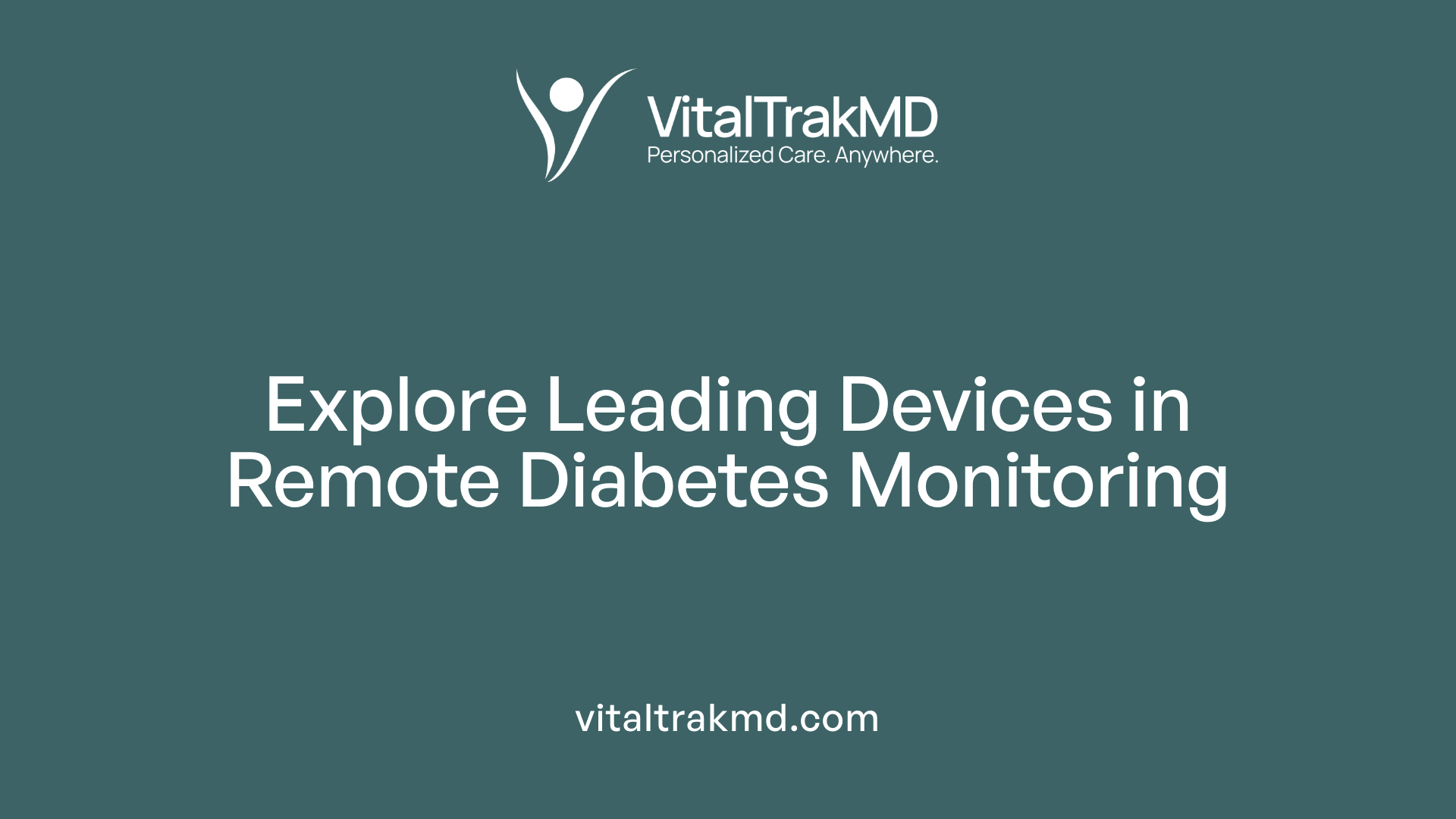
What are common devices used in remote diabetes management?
Remote management of diabetes relies heavily on a variety of technological devices that enable continuous monitoring, data sharing, and efficient treatment adjustments. Among the most prominent are continuous glucose monitoring (CGM) systems. Devices like the Dexcom G6, Medtronic Guardian 3, and Freestyle Libre are widely adopted in clinical practice and by patients. These systems continuously measure glucose levels and wirelessly transmit the data to smartphones, dedicated monitoring platforms, or integrated clinical systems, providing real-time insights into blood sugar trends.
Connected blood glucose meters, such as those produced by Accu-Chek and OneTouch, complement CGMs by offering point-of-care testing that also links directly to cloud platforms or apps. This connectivity allows patients and providers to review blood glucose levels remotely, supporting timely decision-making.
Insulin delivery systems have evolved beyond traditional pumps. Modern insulin pumps, especially those integrated with CGM technology, enable automated insulin dosing—that is, closed-loop systems often referred to as artificial pancreas devices. These pumps adjust insulin delivery based on real-time glucose data, reducing the risk of hypo- or hyperglycemia.
Smart insulin pens and pen caps are additional tools that track insulin doses electronically. They sync with mobile apps, providing data on dosage patterns and offering insights for both patients and healthcare providers.
Wearables and health applications also play a significant role in comprehensive diabetes management. Fitness trackers and activity monitors keep tabs on physical activity, sleep, and lifestyle behaviors, while dedicated health apps consolidate glucose data, medication schedules, and lifestyle factors, encouraging adherence and personalized care.
Collectively, these devices enable a holistic approach to remote diabetes management, supporting proactive treatment, reducing acute complications, and improving overall glycemic control. Their seamless integration with telemedicine platforms facilitates ongoing communication between patients and providers, making it possible to adjust treatments promptly without the need for frequent in-person visits.
Overview of Devices Supporting Remote Diabetes Management
| Device Type | Examples | Functionality | Clinical Role |
|---|---|---|---|
| Continuous Glucose Monitors | Dexcom G6, Medtronic Guardian 3, Freestyle Libre | Real-time glucose measurement, wireless data transmission | Automates glucose tracking, informs insulin adjustments |
| Connected Blood Glucose Meters | Accu-Chek, OneTouch | Point-of-care blood sugar testing with internet connectivity | Facilitates remote review and monitoring |
| Insulin Delivery Systems | Insulin pumps, hybrid closed-loop pumps | Automated insulin dosing based on continuous data | Maintains better glycemic control |
| Smart Insulin Pens and Caps | Digital pens, Capella, InPen | Tracks insulin doses, app integration | Provides dosing history, aids in adherence |
| Wearables and Health Apps | Fitness trackers, lifestyle apps | Monitors physical activity, sleep, health metrics | Promotes lifestyle management, supports personalized care |
Search Query for Further Information
"Diabetes devices remote management, CGM systems, insulin pumps, connected meters"
Remote Blood Sugar Monitoring Technologies
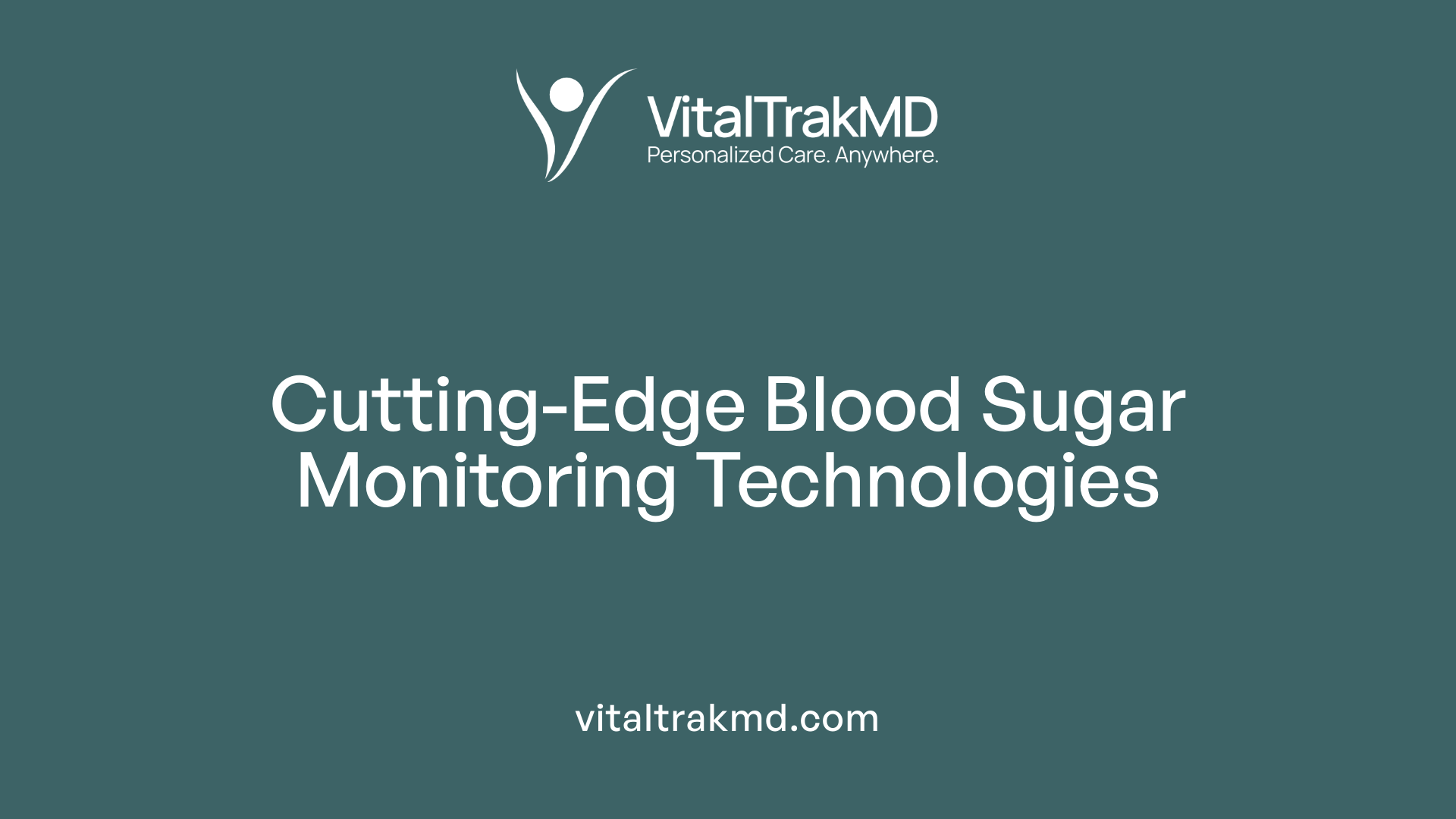
How can blood sugar be monitored remotely in diabetes management?
Remote blood sugar monitoring has revolutionized diabetes care, making it more accessible and efficient, especially for those in rural or underserved areas. The core of this technology lies in advanced devices that automatically transmit data to healthcare providers, enabling real-time oversight and timely intervention.
One of the most prominent tools in remote monitoring is the Continuous Glucose Monitoring (CGM) system. Devices from brands like Dexcom, Medtronic, and Freestyle Libre continuously measure glucose levels in the interstitial fluid. These systems provide real-time data, which patients can view on their smartphones or dedicated readers. The data typically include current glucose levels, trends over time, and alerts for hypo- or hyperglycemia, helping patients manage their condition proactively.
These systems also facilitate remote review by healthcare providers through proprietary platforms or integrated mobile apps. This ongoing data collection allows for more personalized treatment adjustments without the need for frequent in-office visits.
In addition to CGMs, Bluetooth-enabled blood glucose meters have become an essential part of remote monitoring. These devices automatically transfer readings to telehealth systems, electronic health records (EHR), or patient portals. This automatic data transfer reduces manual logging errors and saves time, ensuring that clinicians have access to up-to-date information.
Integration extends further with smart insulin pens and pumps that work in tandem with CGM data. Automated insulin delivery systems, or closed-loop systems, adjust insulin doses based on glucose readings, providing a semi or fully automated way to manage blood sugar levels remotely.
Overall, these technological advancements empower patients to take charge of their health, improve glycemic control, and facilitate swift clinical responses. The seamless integration of devices with telehealth platforms and EHR systems enhances communication, supports decision-making, and promotes better health outcomes.
Types of remote monitoring devices and their features
| Device Type | Functionality | Data Transmission Method | Typical Use Cases |
|---|---|---|---|
| Wireless CGM Systems | Continuous glucose readings, real-time alerts | Wi-Fi, Bluetooth | Adults and children requiring tight glucose control |
| Bluetooth-enabled glucometers | Automatic transmission of fingerstick readings | Bluetooth | Daily monitoring for Type 2 diabetes |
| Insulin pumps & smart pens | Automated or remote insulin dosing | RF, Bluetooth | Integrated management with CGM |
| Additional Devices | Blood pressure, weight, activity tracking | Wi-Fi, cellular data | Comorbid conditions management |
Integration with telehealth and electronic health records
The successful remote management of diabetes hinges on seamless integration of device data with telehealth systems and EHRs. This compatibility allows clinicians to monitor multiple patients efficiently, review trends, and make informed decisions remotely.
For example, a digital platform can display ambulatory glucose profiles (AGP) and other analytics, providing a comprehensive view of patient status. This integration also supports automated alerts for potential emergencies and helps in scheduling timely interventions.
Future directions in automated insulin systems
Emerging technology points toward fully automated insulin delivery, where CGM data feeds into algorithms that adjust insulin doses in real time. These closed-loop systems hold promise for achieving better glycemic control, reducing the burden on patients, and preventing complications.
As the technology evolves, these devices will become more user-friendly, affordable, and widely available, further transforming how diabetes is managed remotely.
Understanding Remote Patient Monitoring (RPM) in Diabetes
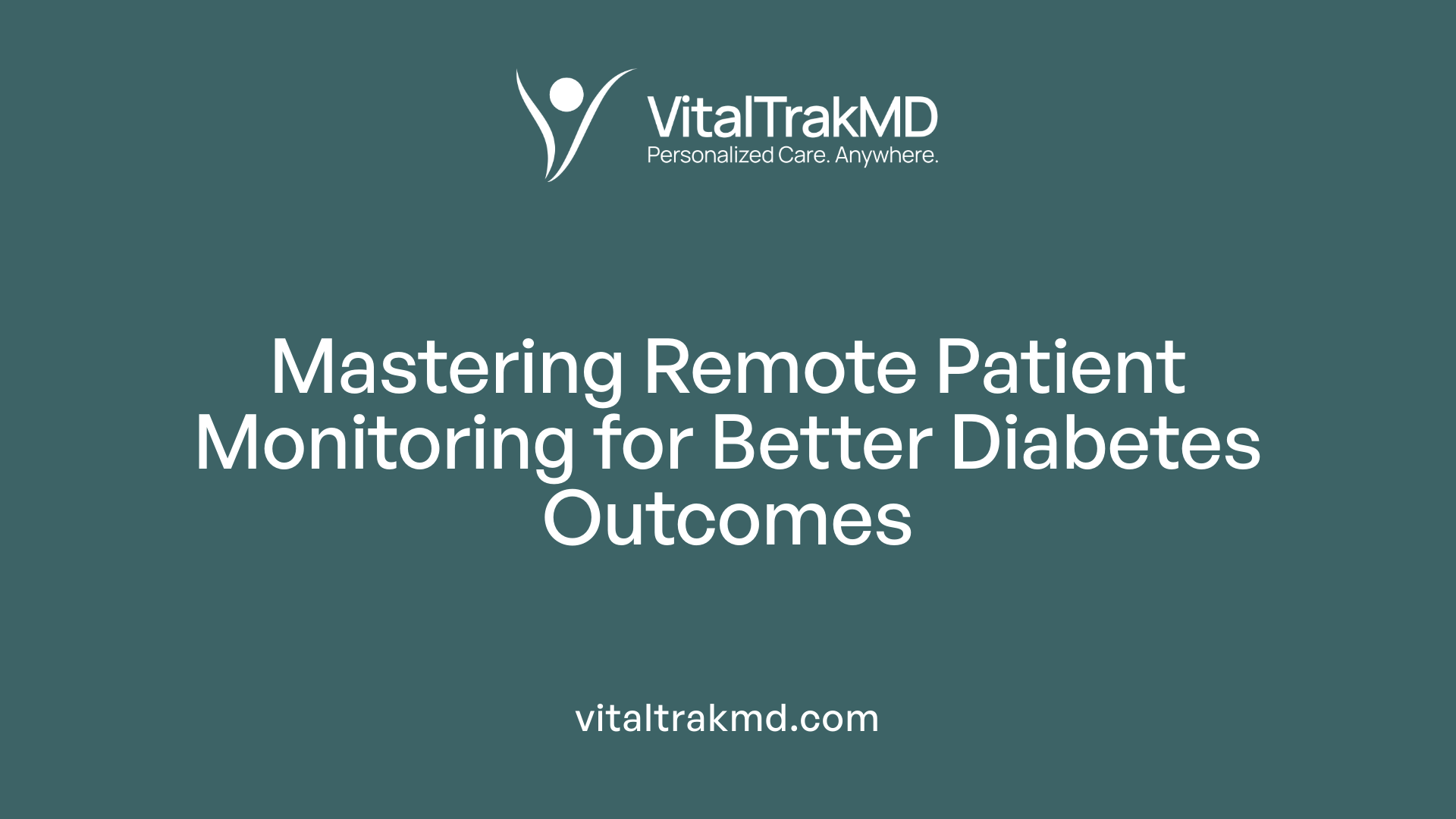
What is remote patient monitoring for diabetes?
Remote patient monitoring (RPM) for diabetes involves the use of digital devices and advanced technologies to collect, transmit, and analyze blood glucose levels remotely. This approach enables continuous or frequent data collection without the need for in-person visits. Common tools used in RPM include continuous glucose monitors (CGMs), which provide real-time glucose readings; connected glucose meters that automatically upload data; insulin pumps and smart insulin pens that track insulin delivery; and digital health apps that assist in managing data and medication schedules.
These devices typically feature wireless communication capabilities such as cellular networks or Bluetooth, which facilitate automatic and seamless transmission of health data to healthcare providers. The data is often integrated into electronic health records (EHRs) or dedicated clinical platforms, allowing clinicians to review, analyze, and make timely treatment adjustments.
RPM programs aim to improve glycemic control by offering frequent monitoring opportunities, thus enabling early detection of abnormalities like hypoglycemia or hyperglycemia. This continuous flow of information also helps prevent complications related to diabetes, such as retinopathy, nephropathy, and cardiovascular issues.
Moreover, RPM enhances patient engagement by empowering individuals to actively participate in their own care. Patients can receive personalized feedback, alerts, or education based on their real-time data. Overall, RPM in diabetes management promotes better health outcomes, offers convenience, and supports more personalized, flexible care strategies.
Continuous data collection: CGM, connected meters, insulin pumps
In diabetes management, continuous data collection is essential for maintaining tight glycemic control. CGMs are at the forefront, constantly monitoring glucose levels through sensors typically worn on the body, transmitting data every few minutes.
Connected glucose meters and smart insulin pens further augment this data stream by automatically uploading readings to cloud platforms or healthcare systems. Insulin pumps with integrated monitoring capabilities allow for real-time adjustments in insulin delivery based on ongoing glucose data.
These devices work together within RPM systems to offer a comprehensive picture of a patient's glucose trends over time, aiding in the detection of patterns and informed decision-making.
Wireless communication: cellular, Bluetooth
Wireless communication technologies are vital to the effectiveness of RPM devices. Cellular networks enable data transmission from devices to cloud servers or clinical dashboards even in remote areas with limited internet infrastructure. Bluetooth, on the other hand, facilitates short-range communication between patient devices and smartphones or tablet apps, which act as intermediaries to upload data securely.
Both communication methods ensure that clinicians receive continuous, real-time updates. This connectivity also supports alerts for abnormal glucose levels, medication reminders, and data sharing with family or caregivers, enhancing overall safety and patient adherence.
Benefits: glycemic control, complication prevention, engagement
Implementing RPM in diabetes care has demonstrated significant benefits. Improved glycemic control, indicated by reductions in HbA1c levels, is one of the most notable outcomes. Studies have shown that regular remote monitoring can lead to a decrease of approximately 0.55% in HbA1c, helping prevent long-term complications.
Furthermore, continuous data allows for early intervention to manage hypoglycemia or hyperglycemia, thereby reducing emergency visits and hospitalizations. RPM also promotes complication prevention by enabling tight blood glucose regulation.
Engagement is significantly enhanced as patients become active participants in their care. They receive real-time feedback, education, and encouragement, fostering healthier behaviors and lifestyle modifications.
Clinical workflows: data review, treatment adjustments
Integrating RPM into clinical workflows involves systematic review of remote data. Healthcare professionals analyze glucose trends using standardized reports such as ambulatory glucose profiles (AGP) and other metrics like %TIR, %TBR, and GMI.
Clinicians can promptly adjust medications, insulin dosages, or lifestyle recommendations based on this data. The process requires dedicated responsibilities for staff, clear protocols, and effective communication channels.
Establishing routines for data review, patient follow-up, and treatment modifications ensures consistency and maximizes the benefits of RPM systems. Training staff to interpret complex glucose reports and communicate recommendations virtually is essential for seamless, effective diabetes management.
| Device Type | Connectivity Technologies | Main Benefits | Typical Use Cases |
|---|---|---|---|
| CGM | Bluetooth, Cellular | Continuous glucose data; early alert | Pediatric and adult diabetes, especially T1D |
| Connected Glucose Meters | Bluetooth, Cellular | Automatic uploads; ease of use | Routine SMBG, medication titration |
| Insulin Pumps | Wireless, Bluetooth | Precise insulin delivery and data sharing | T1D patients requiring intensive insulin therapy |
| Digital Health Apps | Smartphone-based | Data visualization; goal setting | Self-management and provider monitoring |
Search Query
RPM for diabetes, remote glucose monitoring, digital health devices
Through continuous innovation and integration, RPM offers a promising avenue to enhance diabetes management, improve patient quality of life, and reduce healthcare costs.
Impact of Digital Health Devices and Platforms
What is the role of digital health tools and devices in remote diabetes management?
Digital health tools and devices have revolutionized the way diabetes is managed remotely, making continuous and real-time monitoring a practical reality. Devices such as continuous glucose monitors (CGMs), connected glucose meters, insulin pumps, smart insulin pens and caps, and health apps enable patients to measure their blood sugar levels at home with ease and transmit this data automatically to healthcare providers.
These devices facilitate instant data sharing through secure electronic health records (EHRs) and interoperable digital platforms. This integration supports clinicians in making timely, informed decisions tailored to individual patients. For example, advanced CGMs like Dexcom G6 or Freestyle Libre provide detailed glucose profiles, including metrics like Time in Range (TIR), Time Below Range (TBR), and the Glucose Management Indicator (GMI), which are essential for fine-tuning therapy plans.
Furthermore, these digital tools enhance clinical decision-making with AI-driven predictions and hypoglycemia alerts based on physiological signals. These features allow for proactive interventions to prevent complications. Telehealth platforms expand care access, especially in underserved or rural areas, by enabling virtual consultations, remote therapy adjustments, and continuous patient engagement.
Patient empowerment is a vital aspect of these technologies. Mobile apps and coaching services encourage self-management by providing real-time feedback, educational content, and community support. This not only improves adherence to treatment but also increases patient safety, enhances clinical outcomes such as HbA1c reduction, and fosters a collaborative approach between patients and healthcare teams.
In summary, digital health tools and devices serve as the backbone of remote diabetes management, offering comprehensive data collection, analysis, and communication channels that lead to safer, more personalized, and accessible care for individuals living with diabetes.
Supporting Diabetes Care through Telehealth and Telemedicine
How do telehealth and telemedicine support diabetes care?
Telehealth and telemedicine have revolutionized diabetes management by expanding access to care, especially for patients in remote or underserved areas. These technologies enable virtual consultations through video calls, phone, and app-based platforms, making it easier for patients to connect with healthcare providers without physical visits.
An important aspect of telemedicine is remote blood glucose monitoring, where patients use devices like continuous glucose monitors (CGMs) and smart apps to transmit real-time data. This allows clinicians to make timely adjustments to treatment plans, improving blood sugar control and reducing HbA1c levels. Evidence from clinical studies and meta-analyses indicates that telemedicine interventions can lead to significant improvements in glycemic management, benefiting both type 1 and type 2 diabetes patients.
Screening and diagnostics are also enhanced through telehealth. Digital retinal imaging, a form of tele-ophthalmology, has proven effective for diabetic retinopathy screening by increasing access, reducing costs, and maintaining high sensitivity and specificity. Remote foot examinations and other diagnostic assessments support early detection and prevention of complications.
Patient education is a cornerstone of effective diabetes management. Tele-education platforms help promote positive lifestyle changes, reinforce self-care behaviors, and deliver personalized advice. With remote interactions, patients can actively participate in their care, increasing engagement and adherence.
The model of care supported by telemedicine emphasizes patient-centeredness, with flexible scheduling and accessibility tailored to individual needs. During the COVID-19 pandemic, these services proved vital by reducing infection risks and ensuring continuous management.
Overall, telehealth supports comprehensive diabetes care by integrating remote consultations, continuous monitoring, diagnostics, and education—leading to better health outcomes and enhanced patient satisfaction.
Evidence Supporting Remote Diabetes Programs
What evidence exists regarding the effectiveness of remote diabetes management programs?
A growing body of scientific research confirms that remote management initiatives significantly benefit patients with diabetes. Over 100 randomized clinical trials have investigated telemedicine's role in diabetes care, consistently indicating improvements in glycemic control and patient outcomes.
Meta-analyses of these studies reveal that telehealth interventions can yield HbA1c reductions of approximately 0.37% to 0.71%. For instance, interventions involving telemonitoring, virtual clinics, and comprehensive telehealth platforms have demonstrated notable improvements in blood glucose monitoring, with increased time in target ranges and better adherence to treatment protocols.
Continuous glucose monitoring (CGM) integrated into telehealth programs particularly enhances these benefits by providing real-time data, allowing timely treatment adjustments. These digital solutions support better patient engagement and empower individuals to self-manage their condition more effectively.
Beyond clinical outcomes, remote diabetes programs have proven to be cost-effective. They decrease the need for in-person visits, reduce travel expenses, and lower hospital admission rates. This efficiency is especially valuable in rural and underserved areas where access to traditional healthcare can be limited.
During the COVID-19 pandemic, telemedicine became indispensable, ensuring continuity of care while minimizing infection risks. Patients reported high satisfaction levels with remote consultations, citing convenience, reduced travel, and quick access to healthcare providers.
Furthermore, remote management has enhanced specific aspects of diabetes care, such as facilitating retinopathy screening through tele-ophthalmology and supporting early intervention in cases of hypoglycemia or hyperglycemia.
In sum, robust evidence supports the integration of remote programs into standard diabetes management, providing improved health outcomes, increased patient satisfaction, and cost savings. These initiatives are shaping modern, accessible, and patient-centered diabetes care.
Best Practices for Virtual Diabetes Care Delivery
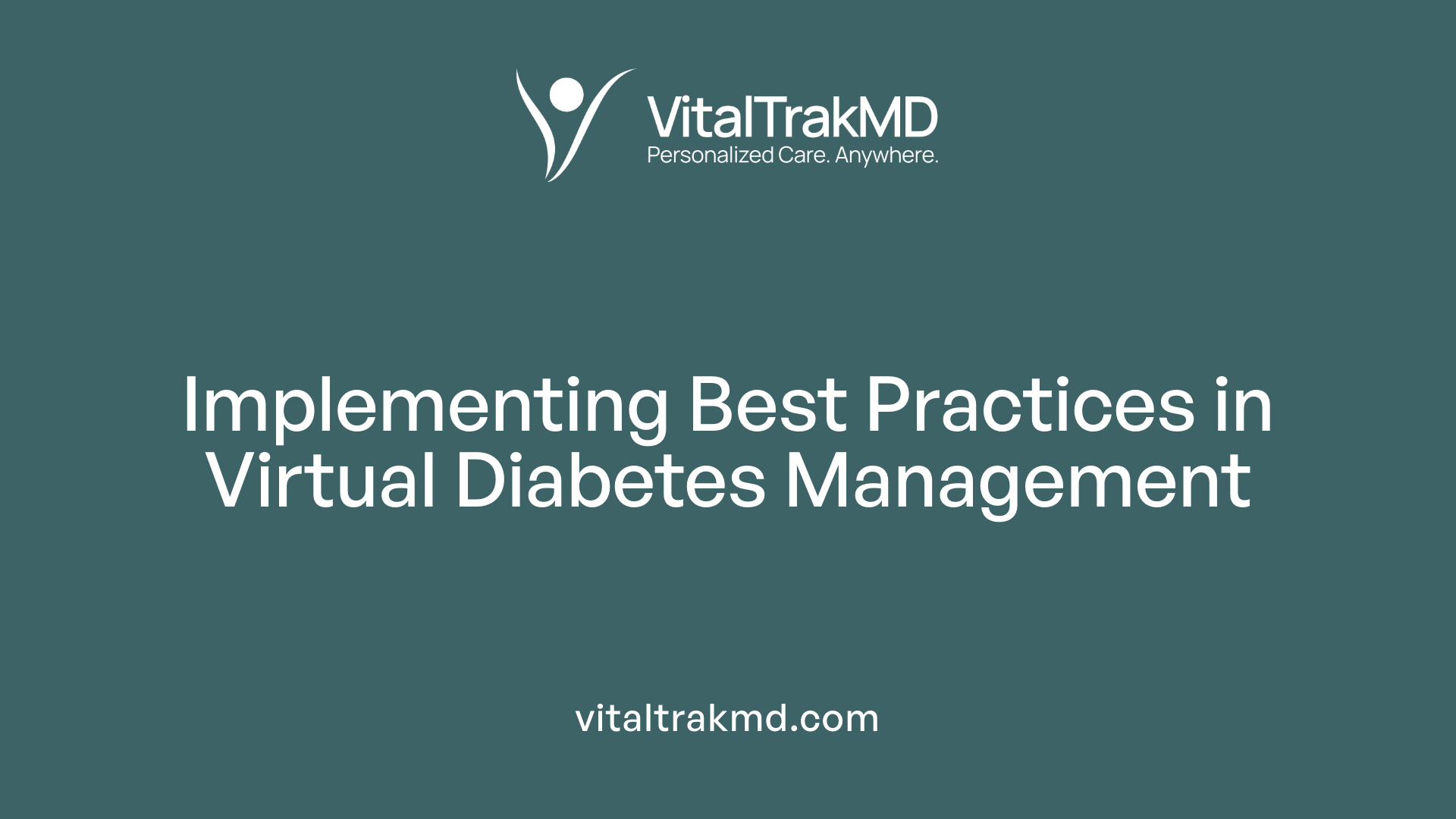
What are the best practices for virtual diabetes care delivery?
Effective virtual diabetes care combines innovative technology, structured clinical workflows, and a patient-centered approach to improve outcomes and patient satisfaction. The foundation of successful remote management involves leveraging a variety of digital tools such as continuous glucose monitors (CGMs), insulin pumps, connected glucose meters, and mobile health applications. These devices provide accurate, real-time data that can be easily uploaded and reviewed remotely.
Regular review of patients' digital data is crucial. Synchronous virtual visits enable healthcare providers to discuss blood glucose trends, medication adjustments, and lifestyle factors in real-time, fostering timely decision-making. It is essential to develop standardized protocols for data review and clinical assessments to ensure consistency and safety.
A team-based approach enhances the quality of care. Involving nurses, dietitians, endocrinologists, and other specialists ensures comprehensive management, addressing not just medical but behavioral and nutritional needs. This multidisciplinary collaboration supports personalized care plans that cater to individual health goals and social circumstances.
Patient education and cultural competence are vital components. Providers should ensure that patients understand how to use their devices effectively and respect cultural differences that might influence treatment adherence. Tailored education, language support, and engagement strategies improve patient involvement and adherence.
Policy support and workflow development facilitate sustainable implementation. Establishing clear procedures for device management, data handling, and reimbursement processes encourages consistent use. Integrating digital data streams into clinical workflows, supported by adequate training and administrative protocols, helps clinicians efficiently manage remote populations.
In conclusion, optimal virtual diabetes care involves a combination of advanced technology, active team collaboration, continuous education, and thoughtful organizational policies. These practices enable personalized, safe, and effective remote management, ultimately leading to improved glycemic control and higher patient satisfaction.
Adapting During the COVID-19 Pandemic and Beyond
How has remote diabetes management evolved during events like the COVID-19 pandemic?
The COVID-19 pandemic marked a turning point for remote diabetes management, transforming it from a supplementary option into a primary mode of care delivery. As in-person visits were limited to reduce infection risk, healthcare providers rapidly adopted telemedicine, integrating a variety of digital health tools into routine practice.
Telehealth platforms, including video consultations and tele-monitoring systems, allowed clinicians to monitor patients' blood glucose levels remotely. Devices like continuous glucose monitoring (CGM) systems, which transmit real-time data, became vital for maintaining glycemic control without physical contact. Patients could upload glucose readings from home devices such as connected meters or CGMs, enabling timely adjustments to therapy.
The transition was supported by regulatory and reimbursement changes, which temporarily relaxed restrictions on telehealth services and expanded coverage. This shift facilitated broader access, especially in rural and underserved areas, and helped prevent disruptions in ongoing diabetes management.
Studies conducted during this period demonstrated that remote management strategies effectively improved clinical outcomes. For example, patients using CGM and telehealth interventions achieved better HbA1c levels and glycemic variability. Moreover, these remote solutions supported patient self-management, education, and behavioral modifications.
The success of these initiatives fostered confidence in virtual care, leading to sustained use even as restrictions eased. The pandemic essentially fast-tracked the integration of digital health into standard diabetes care, highlighting the importance of flexibility, technological readiness, and regulatory support.
Regulatory and reimbursement changes
Entities like the Centers for Medicare & Medicaid Services (CMS) and private insurers expanded telehealth coverage, allowing more flexible billing (such as CPT codes for CGM interpretation) and reimbursing virtual visits at rates comparable to in-person appointments.
Many regions adopted policies to ensure parity between telehealth and in-person billing, which encouraged providers to incorporate remote care options. These changes helped reduce barriers related to cost and access.
Maintenance of care quality and safety
Ensuring the safety and quality of remote diabetes care remained paramount. Practices such as regular data review, patient engagement, and use of standardized reports like the ambulatory glucose profile (AGP) became standard. Clinicians emphasized individualizing care based on transmitted data, managing privacy concerns, and maintaining clear communication channels.
Training for both providers and patients was essential to navigate the new digital landscape effectively. Support services, including helpdesks and tele-education, enhanced the user experience.
Lessons learned and future models
The pandemic underscored the potential for telemedicine to increase access, improve clinical outcomes, and enhance patient satisfaction. Moving forward, permanent policies are expected to evolve to sustain telehealth’s role beyond emergencies.
Future models will likely emphasize hybrid approaches, combining in-person visits with remote monitoring and virtual consultations. Advanced technologies such as AI-driven analytics, blockchain for data security, and integrated device ecosystems will further refine care.
Addressing disparities remains critical, with initiatives needed to improve access among socioeconomically disadvantaged populations, older adults, and non-English speakers.
In conclusion, COVID-19 accelerated the adoption and normalization of remote diabetes management. It showcased the feasibility, safety, and effectiveness of digital health solutions, setting the stage for long-term transformations in diabetes care models.
| Aspect | Change Implemented | Impact | Future Considerations |
|---|---|---|---|
| Adoption | Widespread use of telehealth | Improved access, continuity of care | Sustain policies, expand infrastructure |
| Technology | Integration of CGM, connected devices | Better glycemic outcomes | Enhance device interoperability |
| Policy | Reimbursement expansion | Increased provider participation | Establish long-term regulatory support |
| Patient Engagement | Virtual coaching, remote monitoring | Higher adherence, satisfaction | Personalize digital interventions |
| Safety & Quality | Standardized data review, secure platforms | Maintained care quality | Develop robust guidelines and training |
This evolving landscape reflects a commitment to resilient, accessible, and patient-centered diabetes care well into the future.
The Future of Remote Diabetes Management
What are the future considerations and challenges in managing diabetes remotely?
As technology continuously advances, the landscape of remote diabetes management is poised for significant transformation. Future strategies will likely incorporate AI-driven algorithms that personalize diabetes care, providing tailored treatment plans based on real-time data. These smart systems can predict glycemic trends, optimize insulin dosing, and alert patients and providers to potential issues proactively.
One promising development is the evolution of closed-loop insulin delivery systems, sometimes called artificial pancreas systems. These integrate continuous glucose monitoring (CGM) and insulin pumps to automatically adjust insulin levels, reducing the burden of manual management and improving glycemic outcomes.
Longer-lasting and more accurate CGMs are also on the horizon. These devices will require fewer sensor replacements, making remote monitoring more convenient and sustainable for users.
However, integrating these innovative devices presents interoperability challenges. Creating a seamless ecosystem where different devices and platforms communicate effectively is essential. Standardized data protocols and robust interfaces are necessary to facilitate this integration, ensuring that patients can utilize diverse devices without compatibility issues.
Addressing disparities remains a vital concern. Many populations, especially those in socioeconomically disadvantaged areas or with limited digital literacy, face barriers to benefit fully from remote care. Expanding infrastructure—such as affordable internet access—and providing culturally appropriate, user-friendly education programs will be crucial to promote health equity.
Regulatory and reimbursement frameworks are evolving but must keep pace with technological innovations. Clear policies supporting device approval, data privacy, and coverage will enable broader adoption and sustainability of remote diabetes care. Ensuring patient data security and preventing algorithmic biases are ongoing challenges that require vigilant oversight.
Community engagement and healthcare provider training are also foundational for future success. Educating clinicians on emerging technologies and integrating remote management into routine care pathways will improve outcomes. Likewise, involving patients and communities in the development and deployment of these tools fosters trust and more personalized, effective care.
In summary, the future of remote diabetes management will blend cutting-edge digital innovations with efforts to promote equitable access, regulatory clarity, and stakeholder education. These combined efforts promise to enhance glycemic control, reduce complications, and improve the overall quality of life for individuals living with diabetes.
Resources and Education for Remote Diabetes Care
What resources are available to learn about remote diabetes care approaches?
A comprehensive understanding of remote diabetes care can be achieved through multiple resources designed for healthcare professionals, patients, and caregivers. The American Diabetes Association (ADA) offers a variety of educational programs including online courses, webinars, and certification opportunities that focus on the integration of technology into diabetes management. These programs cover topics such as telemedicine best practices, digital health tools, and strategies to optimize patient outcomes remotely.
Reputable organizations like the Department of Veterans Affairs (VA) and US Diabetes Care provide additional virtual education supports, webinars, and guidelines tailored for both clinical providers and patients, ensuring they remain updated on current standards and innovations.
ADA's website serves as a central hub for resources, featuring telemedicine guidelines, case studies, detailed training materials, and expert recommendations. These resources are invaluable in guiding practitioners to implement effective remote management practices, from teleconsultations and data sharing to patient education.
Digital health tools and mobile applications are also crucial. These platforms facilitate self-monitoring, real-time data transmission, and remote patient monitoring, empowering patients to actively participate in their care. Many apps provide educational content, reminders, and communication features to enhance engagement.
Furthermore, various research articles and published case studies demonstrate the effectiveness of telemedicine interventions in glycemic control, showing reductions in HbA1c levels and improved patient satisfaction.
Government policies and support programs play a vital role, providing funding, technical assistance, and policy frameworks to promote the adoption of telehealth solutions. Programs like the CDC’s initiatives and federal reimbursement policies support the scalability and sustainability of remote diabetes care models.
Together, these resources cultivate a robust foundation for implementing remote diabetes management strategies, ultimately aiming to improve health outcomes, increase access, and reduce disparities in care.
| Resource Type | Examples | Purpose |
|---|---|---|
| Professional guidelines | ADA telemedicine guidelines, VA telehealth protocols | Guidance for clinicians and healthcare systems |
| Online courses and webinars | ADA diabetes tech certification, VA telehealth training | Skill development and knowledge expansion |
| Digital health tools | Glooko, Livongo, MySugr, Dexcom G6 app | Self-monitoring, data sharing, education |
| Research and case studies | Published journal articles, clinical trial results | Evidence-based practice |
| Government programs | CDC telehealth initiatives, CMS reimbursement policies | Policy support and funding |
This interconnected set of resources ensures a continuously evolving landscape of educational and practical tools, helping healthcare providers and patients navigate the complexities of remote diabetes management effectively.
Empowering the Future of Diabetes Management
As the integration of technology and clinical practice continues to advance, remote diabetes management stands poised to transform care delivery, making it more accessible, personalized, and effective. The VitalTrak model encapsulates best practices, innovative devices, and comprehensive strategies to support patients and providers alike. Overcoming barriers—such as digital literacy, infrastructure, and systemic inequalities—will be essential to harness these benefits fully. Embracing ongoing education, policy evolution, and community engagement will ensure that remotely managed diabetes care not only improves outcomes but also becomes a standard component of chronic disease management worldwide. The future of diabetes care is virtual, data-driven, and patient-centered—delivering hope and healthier lives.
References
- Role of Telemedicine in Diabetes Management - PMC
- Remote Patient Monitoring in Diabetes: How to Acquire, Manage ...
- Remote Patient Monitoring in Diabetes: How to Acquire, Manage ...
- Telehealth scenario: Remote patient monitoring (RPM) for diabetes ...
- Maximize Diabetes Care With Remote Patient Monitoring - Tenovi
- Continuous Glucose Monitoring Integration for Remote Diabetes ...
- Getting started: Using telehealth technologies for diabetes care
- RPM Solutions for Diabetes Patient Populations
- Telemedicine in Complex Diabetes Management
- Diabetes remote monitoring program helps manage disease
Recent articles
Want to Feel Better and Live Healthier?
Join hundreds of patients taking control of their health with personalized care that fits their life – not the other way around.
Rated 4.8/5 by 32+ customers







